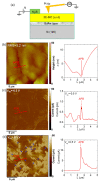New Approaches and Understandings in the Growth of Cubic Silicon Carbide
- PMID: 34576572
- PMCID: PMC8465050
- DOI: 10.3390/ma14185348
New Approaches and Understandings in the Growth of Cubic Silicon Carbide
Abstract
In this review paper, several new approaches about the 3C-SiC growth are been presented. In fact, despite the long research activity on 3C-SiC, no devices with good electrical characteristics have been obtained due to the high defect density and high level of stress. To overcome these problems, two different approaches have been used in the last years. From one side, several compliance substrates have been used to try to reduce both the defects and stress, while from another side, the first bulk growth has been performed to try to improve the quality of this material with respect to the heteroepitaxial one. From all these studies, a new understanding of the material defects has been obtained, as well as regarding all the interactions between defects and several growth parameters. This new knowledge will be the basis to solve the main issue of the 3C-SiC growth and reach the goal to obtain a material with low defects and low stress that would allow for realizing devices with extremely interesting characteristics.
Keywords: 3C-SiC; bulk growth; compliant substrates; defects; heteroepitaxy; stress.
Conflict of interest statement
The authors declare no conflict of interest. The funders had no role in the design of the study; in the collection, analyses, or interpretation of data; in the writing of the manuscript, or in the decision to publish the results.
Figures


























References
-
- Chow T.P. High-voltage SiC and GaN power devices. Microelectron. Eng. 2006;83:112–122. doi: 10.1016/j.mee.2005.10.057. - DOI
-
- Pensl G., Ciobanu F., Frank T., Krieger M., Reshanov S., Schmid F., Weidner M. SiC material properties. Int. J. High Speed Electron. Syst. 2005;15:705–745. doi: 10.1142/S0129156405003405. - DOI
-
- Schöner A., Krieger M., Pensl G., Abe M., Nagasawa H. Fabrication and Characterization of 3C-SiC-Based MOSFETs. Chem. Vap. Depos. 2006;12:523–530. doi: 10.1002/cvde.200606467. - DOI
-
- Uchida H., Minami A., Sakata T., Nagasawa H., Kobayashi M. High Temperature Performance of 3C-SiC MOSFETs with High Channel Mobility. Mater. Sci. Forum. 2012;717:1109–1112. doi: 10.4028/www.scientific.net/MSF.717-720.1109. - DOI
-
- Van Zeghbroeck B., Fardi H. Comparison of 3C-SiC and 4H-SiC Power MOSFETs. Mater. Sci. Forum. 2018;924:774–777. doi: 10.4028/www.scientific.net/MSF.924.774. - DOI
Publication types
Grants and funding
LinkOut - more resources
Full Text Sources
Other Literature Sources

